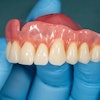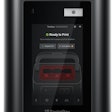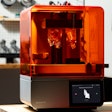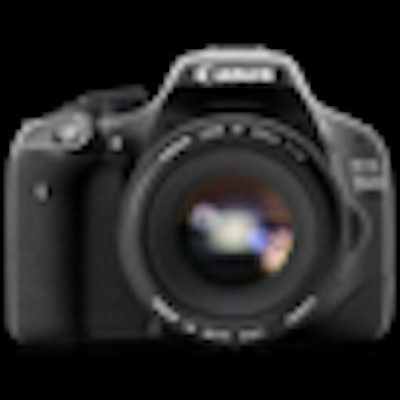
The EOS Rebel T2i, the latest addition to Canon's line of semipro digital single-lens reflex cameras (DSLRs), is garnering rave reviews, prompting one dental photography expert to declare it "a perfect fit for dental offices."
And in a review of the camera published this month, a leading digital photography publication concludes that the T2i is "quite simply ... the best camera of its class that we've ever seen."
What makes this camera so special? The T2i (known outside of the U.S. as the 550D) offers both DSLR and video, is lightweight, features an 18 megapixel sensor, and has 1080i high-definition video-recording capability, according to Charles Payet, D.D.S., a private practice dentist in Charlotte, NC, and author of the Digital Dental Photographer blog.
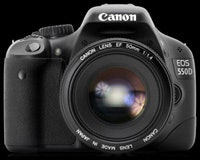 |
|
The new Canon EOS Rebel T2i DSLR camera (known outside of the U.S. as the 550D). |
Pair it with a Canon 60 mm or 100 mm f/2.8 macro lens and the Canon MR-14EX ring flash, Dr. Payet added, "and you are set."
"Any DSLR today is going to provide quality, high resolution, and great color rendition," he said. "People like the point-and-shoot cameras because of the simplicity, but most of them don't offer the flexibility that you need to get good intraoral features."
Point-and-shoot cameras produce good images and are less expensive than DSLRs, but DSLRs produce the highest-quality images, according to Marty Jablow, D.M.D. Good point-and-shoot cameras can be purchased for around $300, while DSLR kits -- which include the camera body, macro lens, and flash attachment -- are in the $1,800 to $2,500 range (the T2i body alone, for example, runs about $749).
"The T2i and DSLRs in general are for people who are a little more serious about their photography," said Lorne Lavine, D.M.D., president of Dental Technology Consultants. "There is no doubt that stepping up to the DSLR is a wise choice for a lot of dental practices, although there is more of a learning curve."
Best of the best?
Of all the DSLR cameras currently on the market, the T2i is the "newest and best," Dr. Payet contends. It has a lot of the same technology as the Canon 700 but with more pro-level features, he said. And with cameras such as the T2i and other "pro-sumer" DSLRs, "the quality of the images is going to continue to improve, especially for things like shade matching," he added.
A comprehensive review of the T2i by Digital Photography Review (April 2010) is equally enthusiastic:
In practice, the camera does not disappoint, and in all respects it gives excellent performance, at least matching but in most cases bettering the best of the competition. ... [It] certainly offers the most compelling feature set of any nominally 'entry level' DSLR that we've used. ... With all this taken into account, it is hard not
to recommend the EOS 550D. Quite simply, taken as a whole, it is the best camera of its class that we've ever seen.
"All the reviews we've seen of the T2i have been glowing," Dr. Lavine noted. "And pricewise, $1,500 to $1,800 for the kit is nothing. With the T1i, its predecessor, we've seen prices that are $1,800 to $1,900. Even point-and-shoot packages with all the bells and whistles are in the $1,400 to $1,500 range. So for only a few hundred dollars more, you are getting a significantly better camera [with the T2i]."
Multiple applications
Regardless of which camera you choose, Dr. Payet and Dr. Lavine are vocal proponents of adding digital imaging to your practice for applications ranging from patient testimonials and case presentation/acceptance to internal and external marketing.
"You can use this for a lot more than just taking pictures of teeth," Dr. Payet said. "When patients can see their own condition, it is easier for them to believe. And I recommend the DSLR because if you show a patient a tooth, they'll fix a tooth. If you show them a quadrant, they'll fix a quadrant. The more you show them, the more they'll have the opportunity to understand, accept, and go forward with treatment."
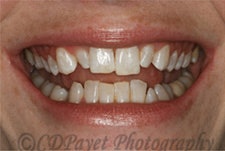 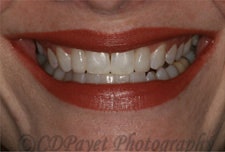 |
| Before (top) and after (bottom) shots of a smile makeover: six-months braces and Cerec porcelain veneers. Images courtesy of Dr. Charles Payet. |
In addition, using the DSLR's video capability, you can take patient testimonials or even record what the patient wants in terms of, say, veneers and then send the images and video to the lab for better communication.
"The ability to communicate between the dentist and patient, dentist and lab, and dentist and public is much improved," Dr. Payet said.
High-quality digital images are also useful for marketing, he said.
"I put pictures of my patients on my office walls," Dr. Payet said. "It's a way of saying, 'This is real work, by me. This is what you can really get in my office, from me.' " He posts patient case images on his office Web site and blog for the same reason, he said.
"Most dentists are using digital cameras for patient education," Dr. Lavine said. "But the fact that you can do video recording as well is great, and the high-definition video you can take with these cameras is amazing. We believe that offices, from a marketing standpoint, should be taking patient testimonials and put them on their Web sites. And it's another added bonus to be able to do this with a single camera."
DSLR cameras can also help dentists document their work. Dr. Payet tags and catalogues his images with regard to bonding agent, porcelain, isolation method, and other keywords so that, over time, he can see how different products hold up.
"I use it personally to study my own work and see what I can do to improve," he said. "It also has protected me from a couple of board complaints by helping to refute a patient's claims against me."
Overcoming the learning curve
Despite all the advantages of DSLR cameras such as the T2i, however, fewer than 40% of U.S. dental offices currently incorporate cameras into their practices for these purposes, Dr. Payet noted.
"Most people still get so intimidated when they see the big camera with the big lens and flash, and they think, 'It must be complicated,' " he said. "But the truth is, with DSLRs today, once you get it, it's basically a big, fancy-looking point-and-shoot camera."
Dr. Lavine agreed, noting that using photos to document cases is needed more for some specialties, such as orthodontics and cosmetic dentistry, than others, such as periodontics and endodontics.
"We find digital photography is as much an art as it is a science," he said. "You will really benefit from taking a course or having someone come into your office" to demonstrate how to best incorporate this technology into your practice, he added.
Copyright © 2010 DrBicuspid.com



